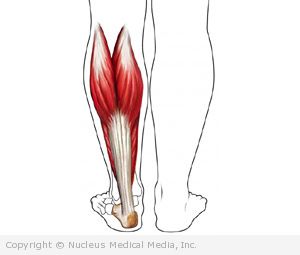Calf muscle strain
(Pulled Calf Muscle; Gastrocnemius Strain; Gastrocnemius Tear; Gastrocnemius Muscle Injury)
Calf muscle strain – Definition
A strained calf muscle is a partial tear of the small fibers of the muscles. The calf muscles are located in the back of your lower leg.
Calf muscle strain – Causes
A calf strain can be caused by:
- Stretching the calf muscles beyond the amount of tension that they can withstand
- Suddenly putting stress on the calf muscles when they are not ready for the stress
- Using the calf muscles too much on a certain day
- A direct blow to the calf muscles
Calf muscle strain – Risk Factors
These factors increase your chance of a strain. Risk factors for calf muscle strain include:
- Sports that require bursts of speed, such as:
- Running
- Hurdles
- Long jump
- Basketball
- Soccer
- Football
- Rugby
- Fatigue
- Tight calf muscles
- Overexertion
- Cold weather
Calf muscle strain – Symptoms
Symptoms of calf muscle strain include:
- Pain and tenderness in the calf
- Stiffness in the calf muscles
- Weakness of the calf muscles
- Pain when pushing off the foot or standing on tiptoe
- Bruising on the calf (if blood vessels are broken)
- Popping sensation as the muscle tears (possibly)
Calf muscle strain – Diagnosis
The doctor will ask about your symptoms and medical history. They will also ask about your recent physical activity and how the injury occurred. The doctor will also examine your calf for:
- Tenderness and/or bruising directly over the calf muscles
- Pain when contracting the calf muscles, particularly against resistance
The following tests might also be done:
Blood tests
- MRI scan — a test that uses magnetic waves to show the structures inside the knee joint
- Doppler ultrasound — a test that uses sound waves to examine parts of the body
- Muscle strains are graded according to their severity.
Grade 1
- Stretching with some microtearing of muscle fibers
- Recovery can be complete in about 2 to 3 weeks
Grade 2
- Partial tearing of muscle fibers
- Recovery can take up to 1 to 2 months
Grade 3
- Complete tearing (rupture) of muscle fibers
- Complete recovery can take more than 3 months
For a severe calf strain, athletes may have an MRI scans. The scan will help predict the length of their recovery.
Calf muscle strain – Treatment
Treatment depends on the severity of the strain.
Treatment usually includes:
Medications
Your doctor may recommend that you take over-the-counter medicines, such as aspirin, ibuprofen, or acetaminophen, to help relieve pain. Topical pain medicines (eg, creams, patches) applied to the skin are another option.
If you still have tenderness in the calf while taking these drugs, do not return to physical activity. Check with your doctor.
Self-care
Start within first 24 hours:
- Rest — Do not do activities that cause pain, such as running, jumping, and weightlifting using the lower leg muscles. If normal walking hurts, shorten your stride. Do not play sports until the pain and local tenderness are gone.
- Cold — Apply ice or a cold pack to the calf area for 15–20 minutes, 4 times a day, for several days after the injury. Wrap the ice or cold pack in a towel. Do not apply the ice directly to your skin.
- Compression — Wear an elastic compression bandage (eg, Ace bandage) around your lower leg to prevent additional swelling. Wrap from the toes up the leg so as to not cause swelling below the wrapping. Be careful not to wrap the bandage too tightly.
- Elevation — Keep your leg higher than your heart as much as possible for the first 24 hours to minimize swelling.
- It is best not to take aspirin or ibuprofen during the first 24 hours if you have a lot of swelling. These medicines can interfere with the clotting mechanism.
Continued care:
- Heat — Do not use heat at all during the first 3-5 days. Use heat only when you are returning to physical activity. Then use it before stretching or getting ready to play sports.
- Stretching — When the acute pain is gone, start gentle stretching as recommended by a health care professional. Stay within pain limits. Hold each stretch for about 10 seconds and repeat 6 times. Repeat stretches 4-6 times during the day.
- Strengthening — Begin strengthening exercises for your calf muscles as recommended by a professional. This is very important to guard against further problems.
If you are diagnosed with a calf muscle strain, follow your doctor’s instructions.
Calf muscle strain – Prevention
To reduce the chance that you will strain a calf muscle:
- Keep your calf muscles strong so they can absorb the energy of sudden physical stress
- After a short warm-up period, stretch out your calf muscles before physical activity
- Learn the proper technique for exercise and sporting activities to decrease stress on all your muscles

